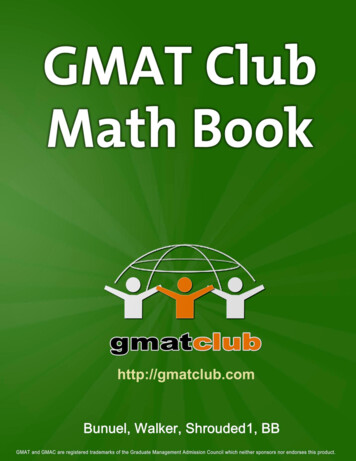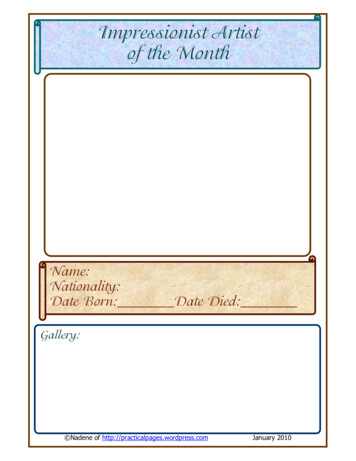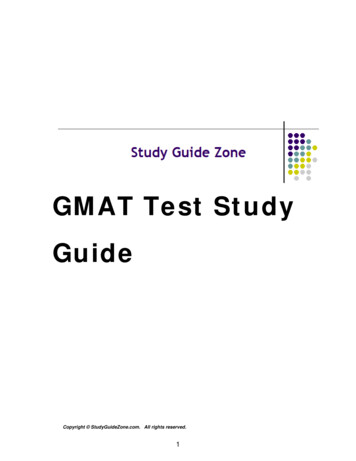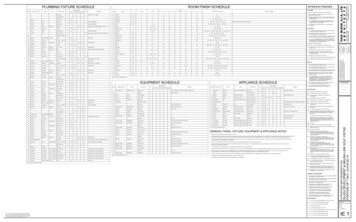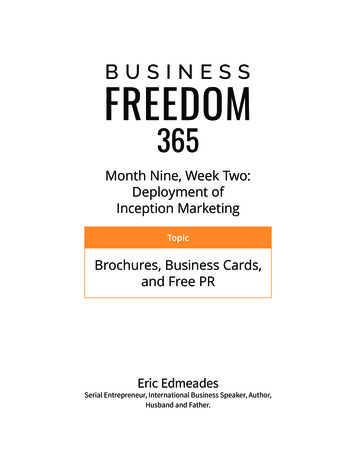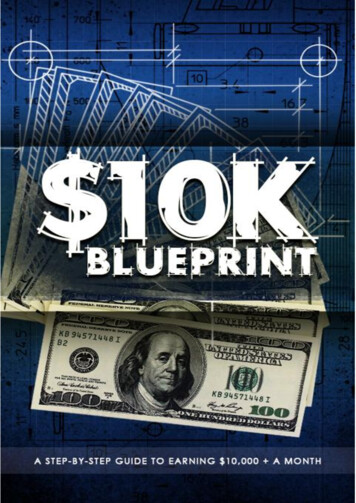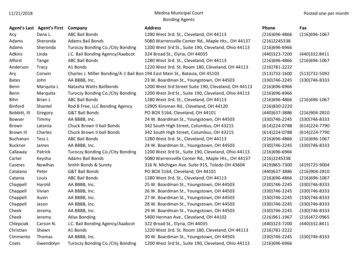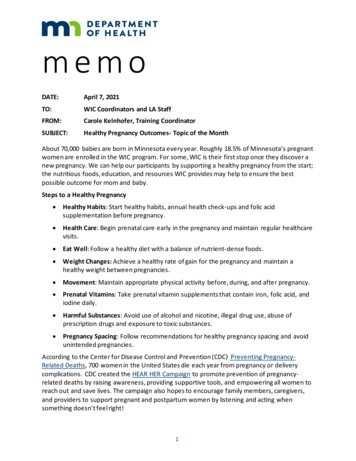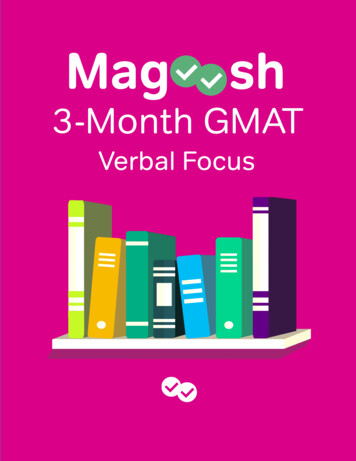
Transcription
If you want to prepare for the GMAT in three months and you need to boost yourverbal score, you’ll need a strong GMAT verbal study plan to help you get there. Withthat in mind, Magoosh’s experts have put together this plan to help you figure outhow to study GMAT verbal!Not only will this GMAT verbal study plan help you to get organized, but it will alsotake you through the major content areas of the test in depth, from CriticalReasoning to Sentence Correction to Reading Comprehension. Ready to dive in?Table of Contents Study Materials Practice Tests AbbreviationsThe GMAT Verbal study plan: Month 1Month 2Month 3After Month 3: Prepare for GMAT test day, test day checklist, andmoreDo you need to adapt this GMAT verbal study plan to meet your needs? Check outthis blog post for adjustment tips!1
Study MaterialsEssential MaterialsGMAC’s The Official Guide for GMAT Review (OG) – The newest edition is theOG2020. If you are going to buy a new guide, get that one. If you happen toown either the OG2019, OG2018, OG2017, or even the previous OG2016,then it would be no problem using either of those with this study guide.Don’t write in the official guide or any prep books. Do all your work onseparate paper or on a computer. If you need to look at a problem again,it is still fresh and unmarked.The code in the back of the OG will give you access to GMAC’sIntegrated Reasoning website with 50 IR practice questions; you’ll alsoneed these.A Premium subscription to MagooshThe Magoosh mobile app for your iPhone or Android2
The Magoosh GMAT eBookThe Magoosh GMAT Math FlashcardsThe Magoosh GMAT Idiom FlashcardsThree volumes of the 10-volume Manhattan GMAT series. These books areabout the best material available in hard-copy print form. The volumes youshould get for this GMAT verbal study plan are: Critical Reasoning, ReadingComprehension, or Sentence Correction. The primary reason you are gettingthis volume is to get the code in the inside back cover: that code will give youaccess to one MGMAT online GMAT CAT, which you will take later in thisGMAT verbal study plan.Once again, it is important not to write in these books, as you will gothrough them twice.A journal or notebook (yes, a physical hard copy item)The two online forums: GMAT Club and Beat the GMAT: These are greatplaces to ask questions about anything GMAT related, or simply to check outthe discussions and see how others are preparing.Outside reading material: We recommend outside reading, over and aboveany GMAT-specific materials, because a habit of reading is one of the bestways to improve your GMAT verbal score across the board. In particular, fornon-native speakers, a habit of outside reading is essential for masteringthe GMAT Verbal section. It’s very important for non-native speakers to pushthemselves to read material as sophisticated and challenging as they canhandle.Read the Wall Street Journal and the business section of sophisticatednewspapers such as the New York Times and the Washington Post. Forceyourself to read articles discussing topics with which you are unfamiliar. Readperiodicals, such as the Economist magazine and Bloomberg Businessweek;the Economist magazine is a particularly sophisticated source and it would begood to read this at least a few times a week. For more suggestions on what toread, see: GMAT Reading List.3
For more on how to use outside reading to prepare you for the GMAT, see:How to Improve your GMAT Verbal ScoreMagoosh’s Complete GMAT Guide: This comprehensive web-based guide tothe GMAT gives you the quick but useful overview you need to understand thistest. You’ll see how the GMAT is designed and scored, what skills it tests, howto find and use the best GMAT prep, and how to study for GMAT test sections.A guide to GMAT Practice Test Resources: This page includes instructions onwhere to find good full-length GMAT practice tests, and how to take practicetests and incorporate them into your studies.Optional MaterialNova’s GMAT Math Prep Course: As explained in this review, this book is purely acollection of practice problems. Because the individual days in this GMAT verbalstudy plan are already busy, I did not assign any problems from this book.If you find you have some additional time, and would like to challenge yourself withmore math practice, then by all means, get this book, and you will have math practiceproblems to your heart’s content. If you can do everything in this book, in addition toall the math problems included in this GMAT verbal study plan, you will able to handleanything the GMAT Quant section throws at you.How to Use Practice Tests During This GMAT Verbal Study PlanThis study plan is designed to accommodate a large number of practice tests, forstudents who feel that the repeated experience will best prepare them for the GMAT.Most of these take place in the second half of the plan. You have a choice to makeabout how many practice GMATs you want to take.You will take one Magoosh practice test toward the beginning of the GMATverbal study plan. If you don’t foresee yourself taking more than 2-3 practicetest after that, then get the single MGMAT book for a single MGMAT practicetest, take this on any Day Six. Fill the other Day Sixes with any studying youthink would most benefit you, and take the two GMAT Prep tests at the end.4
If you want to take the maximum number of practice GMATs that this GMATverbal study plan will accommodate, then there are two ways you can get allsix of the MGMAT practice. One would be to buy the whole set of MGMATbooks: I would recommend this if you imagine that you will have a great deal ofextra time and would like to devote that time to studying more high-qualityresources. A quicker and cheaper way to get the six MGMAT practice testswould be to pay 50 to buy the 6 MGMAT Practice GMAT CATs by themselves.Abbreviations in the GMAT Verbal Study Plan OG the GMAC Official GuidePS Problem Solving, the multiple-choice math questionsDS Data Sufficiency math questionsRC Reading Comprehension verbal questionSC Sentence Correction verbal questionCR Critical Reasoning verbal questionIR Integrated Reasoning question, a separate section unto itselfAWA the Analytical Writing Assessment, the essay-writing sectionGMAT Verbal Study Plan: Week OneWeek One, Day OneGo to the test-maker’s website and read about the structure of the GMAT.Click on each subsection on that page to read about the individual sections.Take the Diagnostic Test, found toward the beginning of the OG. Grade it, butyou don’t have to read through all the explanations today. If you did muchmuch better than you expected in either math or verbal, you may choose to reevaluate which version (A, B, C, D) you are following.In the Magoosh GMAT Idiom Flashcards, start learning the cards in the firstdeck, the Basic I deck. Spend 10 minutes with these cards.Read the blog article GMAT English.5
Week One, Day TwoFor the Diagnostic test you took yesterday, go over the explanations. Forquestions you got right, simply skim the explanation to verify that you go thequestion right for the right reason. If you got the question wrong, read theexplanation carefully, writing in your journal any math/verbal concept youdidn’t know or understand, as well as anything about the question type thatyou didn’t understand. (If you got many questions wrong on the Diagnostic,you may have to spread this step out over the next few nights)In the OG:Read the introduction to the Problem Solving section, and do 16 PSRead the introduction to the Reading Comprehension section, do 3 RCpassage with all the associated questionsWhenever you do OG questions, always check your answers when you aredone with the batch, and read the explanation of anything you got wrong. Takenotes in your journal on anything you need to remember from the solutions.Note that not all the OG explanations are of high quality, and some are notgood at all. As an alternative, for all the questions in the OG, you can see muchbetter explanations in our video solutions.Intro to the GMAT: all ten videosIn The Magoosh GMAT eBook, read:from the beginning of the book up to, but not including, the AWA sectionfrom the beginning of the Quantitative section up to, but not including,the DS sectionfrom the beginning of the Verbal section up to, but not including, the CRsectionIn the Magoosh GMAT Idiom Flashcards, continue learning the cards in thefirst deck, the Basic I deck. Spend 10 minutes with these cards.Read the blog article Overcome GMAT AnxietyWeek One, Day ThreeIn the OG:6
In the Math Review, read the first twenty pages, taking notes in yourjournal on anything new, rusty, or unfamiliarRead the introduction to the Data Sufficiency section, and do 16 DSquestionsRead the introduction to the Critical Reasoning section, and do 16 CRquestionsWatch Magoosh lesson videos:Math: skim through the 8 videos of the General Math Strategies moduleIn The Magoosh GMAT eBook, read:DS to the end of the Quantitative SectionCR section to the end of the eBookIn the Magoosh GMAT Idiom Flashcards, continue learning the cards in thefirst deck, the Basic I deck. Spend 10 minutes with these cards.Read the blog article Beating GMAT StressWeek One, Day FourIn the OG, read the Math Review, up to the end of the Algebra section, takingnotes in your journal on anything new, rusty, or unfamiliarWatch Magoosh lesson videos:AWA: all five videosIn Magoosh:Do 12 PS questionsDo 13 CR questionsWhenever you do Magoosh questions, if you get a question wrong, watch thevideo right then, and take notes in your journal about what concepts trippedyou up.NOTE: In all Magoosh practice, from the “Start a Practice Session” page, inSection choose the question type; for subjects, clear all, so that no subject ischecked; for difficulty, choose “Adaptive;” and, at least at the beginning, select7
“Unanswered” questions.NOTE: When you do Magoosh practice questions, do not select individualtopics that are familiar. When you learn a particular lesson, resist the urge topractice that material right there and then. This GMAT verbal study plan isbased on the philosophy that you should see a random mix of topics everytime you practice as you move through the OG. Yes, this means you will makesome mistakes in the beginning, especially with topics you haven’t learnedthoroughly yet, but if you study those mistakes carefully, that will prime yourmind for understanding these ideas more deeply when you get to them in thelessons. Also, it’s important to get accustomed as soon as possible to therandom mix of topics you will see, one after the other, on test day.In the Magoosh GMAT Idiom Flashcards, continue learning the cards in thefirst deck, the Basic I deck. Spend 10 minutes with these cards.Read the blog article The GMAT, Business School, and You: the Big PictureWeek One, Day FiveIn the OG, read the Math Review, up to the end of the Geometry section, takingnotes in your journal on anything new, rusty, or unfamiliarIn the OG:Do 16 PS questionsRead the introduction to the Sentence Correction section, and do 16 SCquestionsWatch Magoosh lesson videos:Math: skim the five videos in the Intro to Data Sufficiency ModuleIn the Magoosh GMAT Idiom Flashcards continue learning the cards in the firstdeck, the Basic I deck. Spend 10 minutes with these cards.Read the blog article Zen Boot Camp for the GMATWeek One, Day Six8
In the OG:Finish reading the Math Review, taking notes in your journal on anythingnew, rusty, or unfamiliarRead the introduction to the AWA section; skim the question prompts toget a sense of the varietyIn The Magoosh GMAT eBook, read the AWA sectionRead the following blogs about the AWA section:The Directions for the AWA sectionTypical Flaws in AWA PromptsAWA StrategiesBrainstorming for the AWA AWA Example EssayNow, you are going to write a practice essay. From the Argument AWAprompts in the OG that you just read, pick one at random (or have someonepick it for you), and take 30 minutes to write an essay on the computer. (If youcan turn off spellcheck and autocorrect, do so, as you will not have that featureon test day.)Now that you have this essay, what do you do with it? If you have a friend ormentor who is a gifted writer, see whether they would read the essay for youand critique it. Some folks hire a writing tutor specifically for this. If they arewilling, you can show them the assessment criteria in the OG, and ask them tofollow it. Alternately, you can upload your essay in the online forums and askfor feedback. See this blog for other options.In the Magoosh GMAT Math Flashcards, drill the first three decks: Algebra;Fractions, Ratios, and Percents; and Geometry.NOTE: If you are strong in math, then you probably will breeze through thesecards, knowing just about everything. Note the few cards that you didn’t knowright away.Week TwoWeek Two, Day One9
Watch Magoosh lesson videosVerbal: the first five lesson videosNOTE: In this GMAT verbal study plan, after the intro videos, no further mathlesson videos are assigned, because it is assumed that you are strong atmath. As you practice problems and find math concepts that you would like tounderstand better, dip into the math lessons videos on those particular topics.This plan leaves it entirely to your discretion how much math you want to learnor review.In Magoosh:Do the Quiz at the end of the Arithmetic & Fractions lesson moduleDo 12 PS questionsDo 3 RC passage with all the associated questionsNOTE: In lieu of watching the full math lessons, this GMAT verbal study planwill assign the quizzes at the end of the math modules. If you do well on thequiz, then you probably know most of the math in the module. If you “fail” thequiz, review a few of the videos, and take the quiz again until you can pass it.In the Magoosh GMAT Idiom Flashcards, continue learning the cards in thefirst deck, the Basic I deck. Spend 10 minutes with these cards.In the MGMAT Volume 6: Critical Reasoning read Chapter 1,
03.05.2020 · You will take one Magoosh practice test toward the beginning of the GMAT verbal study plan. If you don’t foresee yourself taking more than 2-3 practice test after that, then get the single MGMAT book for a single MGMAT practice test, take this on any
